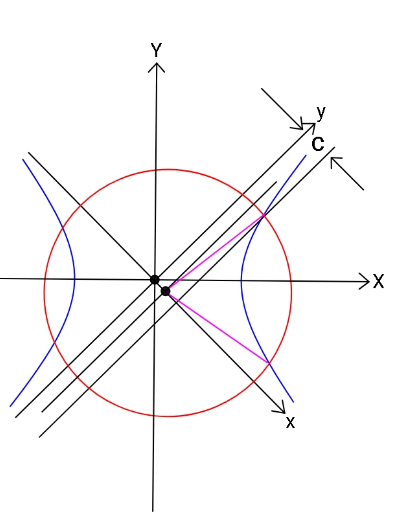
Question Number 124740 by ajfour last updated on 05/Dec/20

Commented by ajfour last updated on 05/Dec/20

$${Find}\:{eq}.\:{of}\:{circle}\:{passing}\:{through} \\ $$$${intersection}\:{points}\:{of}\:\:{curves} \\ $$$${y}={x}^{\mathrm{2}} −\mathrm{1}\:\:{and}\:\:{y}=\frac{{c}}{{x}}\:;\:\:\:\left({c}\:<\:\frac{\mathrm{2}}{\mathrm{3}\sqrt{\mathrm{3}}}\right) \\ $$
Answered by ajfour last updated on 05/Dec/20

$${y}={x}^{\mathrm{2}} −\mathrm{1} \\ $$$${y}=\frac{{c}}{{x}} \\ $$$${let}\:{roots}\:{of}\:\:{x}^{\mathrm{2}} −\mathrm{1}=\frac{{c}}{{x}}\:\:\:{be}\:\:{p},\:{q},\:{r} \\ $$$${p}+{q}+{r}=\mathrm{0} \\ $$$${pq}+{qr}+{rp}=−\mathrm{1} \\ $$$${pqr}={c} \\ $$$$\left({y}−{k}\right)^{\mathrm{2}} +\left({x}−{h}\right)^{\mathrm{2}} ={R}^{\:\mathrm{2}} \\ $$$$\left({x}^{\mathrm{2}} −\mathrm{1}−{k}\right)^{\mathrm{2}} +\left({x}−{h}\right)^{\mathrm{2}} ={R}^{\:\mathrm{2}} \\ $$$${p}\left({q}^{\mathrm{2}} +{r}^{\mathrm{2}} −\mathrm{2}−{k}\right)+{p}+\mathrm{2}{h}=\mathrm{0} \\ $$$$\Rightarrow\:\:{p}\left({p}^{\mathrm{2}} −\frac{\mathrm{2}{c}}{{p}}−\mathrm{2}−{k}\right)+{p}+\mathrm{2}{h}=\mathrm{0} \\ $$$$\Rightarrow\:\mathrm{2}{h}−\left({k}+\mathrm{2}\right){p}+\mathrm{2}{p}−{c}=\mathrm{0}\:\:\:....\left({I}\right) \\ $$$$\Rightarrow\:\Sigma\:\:{gives} \\ $$$$\Rightarrow\:\:\:\:{h}=\frac{{c}}{\mathrm{2}} \\ $$$${And}\:{considering}\:\left({I}\right)\:{again} \\ $$$${with}\:\:{h}={c}\:\:\Rightarrow\:\:\:{k}=\mathrm{0} \\ $$$$\Rightarrow\:\:{R}^{\:\mathrm{2}} \:=\:\left({x}^{\mathrm{2}} −\mathrm{1}\right)^{\mathrm{2}} +\left({x}−\frac{{c}}{\mathrm{2}}\right)^{\mathrm{2}} \\ $$$$\Rightarrow\:\:{R}^{\:\mathrm{2}} =\:\mathrm{1}+\frac{{c}^{\mathrm{2}} }{\mathrm{4}} \\ $$$${Hence}\:{eq}.\:{of}\:{circle}\:{is} \\ $$$$\:\:\left({x}−\frac{{c}}{\mathrm{2}}\right)^{\mathrm{2}} +{y}^{\mathrm{2}} =\mathrm{1}+\frac{{c}^{\mathrm{2}} }{\mathrm{4}} \\ $$$${example}: \\ $$$${For}\:\:\:{c}=\frac{\mathrm{1}}{\mathrm{3}}\:\:,\:{the}\:{curves}\:{are} \\ $$$${y}={x}^{\mathrm{2}} −\mathrm{1}\:\:,\:\:{y}=\frac{\mathrm{1}}{\mathrm{3}{x}}\:,\:\:{and}\:{the}\:{circle} \\ $$$$\left({x}−\frac{\mathrm{1}}{\mathrm{6}}\right)^{\mathrm{2}} +{y}^{\mathrm{2}} =\frac{\mathrm{37}}{\mathrm{36}}\:\:\:\bigstar \\ $$
Commented by ajfour last updated on 05/Dec/20

Commented by mr W last updated on 05/Dec/20

$${fantastic}! \\ $$
Commented by ajfour last updated on 06/Dec/20

